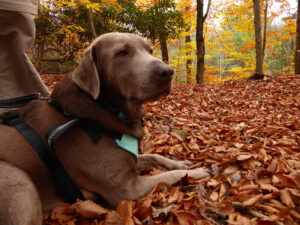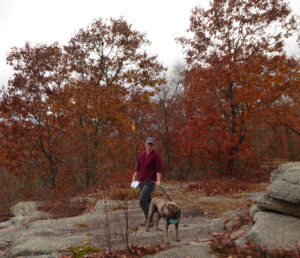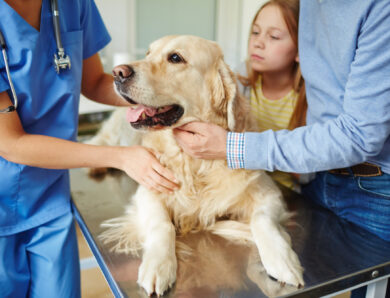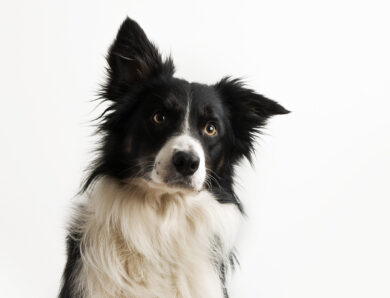
How to Help a Scared Rescue Dog Feel at Home
When you first adopt a dog from an animal shelter or rescue it may seem like your rescue dog is scared of everything.
It sure felt that way with Sylvie when we first got her. She just wouldn’t settle.
A sweet brown lab, she paced the length of our living room like a prisoner measuring her cell. She ignored the chew toy perched invitingly on the corner of her bed and refused offers to join my husband and me on the sofa.
It was her first day with us after a month with a foster family. And while we knew she wouldn’t feel comfortable right away, it was still hard to see how anxious she was.
It’s not uncommon for rescue dogs to be nervous and timid when first adopted.
“When dogs come into a rescue, they’re generally going from wherever home was — whether that was the street, a shelter, or someone’s home. They’re coming into a rescue partner, put on transportation, going to the vet, transferred to a rescue, taken into a foster home,” Colleen Scheuren, of Home at Last Dog Rescue, tells Keeping It Pawsome. (We adopted Sylvie from Home at Last.)
“They’ve been bounced around and there is a lot of nervousness, unfamiliarity, and shyness because they’ve had to readjust every time they’re moved around.”
It’s especially noticeable when they get into their forever home, Scheuren said. They need a decompression period to go from scared rescue dog that doesn’t know what to expect to confident feels-at-home fur baby.
Time to fully acclimate to their new home and routine. Time to trust you and to learn that nothing around them is dangerous.
It’s an adjustment period that could take up to several months.
Fortunately for us, within a couple of days Sylvie started to feel more at home. She began thumping her tail when she saw us and realized that if she jumped up on the sofa she’d get plenty of cuddles and pets. (More than a year later, we can barely get her off the sofa!)
Our vet and the people at Home at Last offered us lots of tips to help her settle in.
Here are eight ways you can help your nervous rescue dog to feel at home.
1. Start with a Stroll

Take your new rescue dog for a walk around your yard or neighborhood before bringing her into the house for the first time. This way she can burn off nervous energy and learn some of the smells around her new home.
It also helps establish where you want your dog to relieve herself. Speaking of which…
Taking longer than expected for your rescue dog to settle? Find out more about how what dogs hear can affect their mood.
2. Expect Accidents
Even a perfectly house-trained dog can be thrown off track by the stress of a new environment, so don’t be dismayed by a few early messes in the house.
If you see an accident in progress, give a gentle correction and take the dog out right away to finish.
Don’t punish your dog by yelling or rubbing his nose in the mess. This will only make him more nervous and delay his progress with you. Just clean it up and try to take him out a little more frequently.
New rescue puppy? Check out our ultimate new puppy checklist.
3. Give Your Dog Some Space
Sometimes Sylvie welcomed our petting, but other times she just wanted to pace around for a bit.
Your rescue dog might want to hide out in a crate or on her bed for a while without anyone getting in her face. Allowing this can help a nervous dog decompress and learn that you can be trusted.
This is particularly important if you have kids who might be eager to shower their new playmate with kisses. For their safety, make sure they allow the dog to come to them rather than vice versa until she’s more familiar with them.
Never leave small children alone with a new animal.
If you have other pets, you might want to keep them in a separate room from your new dog for the first day or two.
Have kids? Here are the top 15 best dogs for a family?
4. Put Guests on Hold
All those family members and friends who are dying to meet your new arrival can wait. Our rescue recommended not introducing Sylvie to anyone outside the household for a couple of weeks. That way she could get to know us before dealing with a flurry of other strangers.
When you do start making introductions, do it one or two at a time instead of bringing in a larger group, so the dog doesn’t feel overwhelmed.
If your dog likes treats, give each new person she’s introduced to a treat to offer.
A trainer might be able to help with an especially scared rescue dog, but first, learn more about how to pick a dog trainer.
5. Don’t Switch Food Right Away
If you can, feed your dog the same food he was eating before he arrived, at least for the first week or so. This can help alleviate any stomach upset.
It also allows your dog a little bit of familiarity in an unfamiliar environment.
Planning on taking your new dog to the beach? Do you know if dogs can get sunburn?
6. Establish a Routine
Adopting a regular schedule will help your dog learn what to expect. Keep her feeding and walking times consistent, and get her accustomed to the type of behavior you expect.
For example, if you don’t want her sleeping in your bed on a permanent basis, don’t let her do so those first few nights just because she looks so sad.
If letting your new rescue pup use the pool is on your to-do list make sure to check out these dog pool safety basics first.
7. Find What Makes Your Dog Comfortable
Getting Sylvie up on the sofa was an early turning point in our relationship with her. It quickly became her favorite spot in the house. The place she retreats to when she has downtime or feels anxious.
For your scared rescue dog, it might be a crate or favorite toy that provides comfort.
Take time to experiment, keeping in mind that your dog’s behavior and preferences probably will change as he settles in.
Don’t have a name picked out for your new best friend? Find out how to pick a pet name.
8. Be Patient and Flexible

You may have fallen in love with your rescue dog at first sight, but it may take her a while to trust you and feel secure in her new environment – especially if she had a rough life before. Give her time, patience and lots of love.
Remember, not everything works the same for every dog. Even though something worked for your neighbor’s nervous rescue dog and he only took five days to adjust, that might not be the same for your dog.





